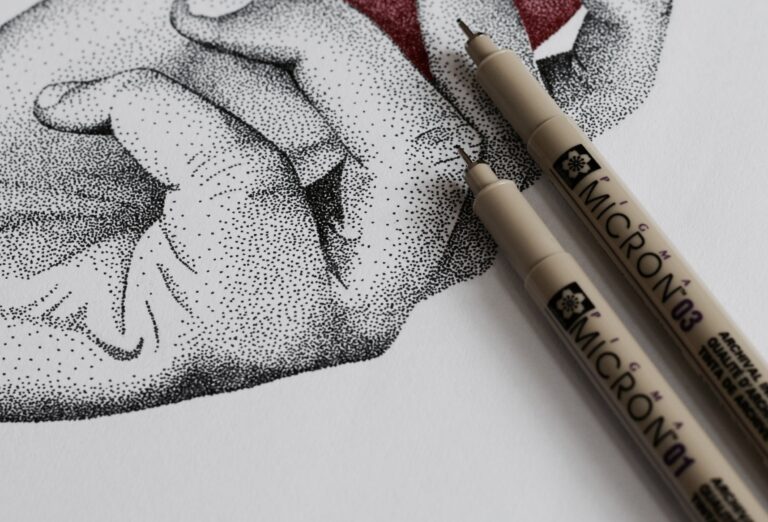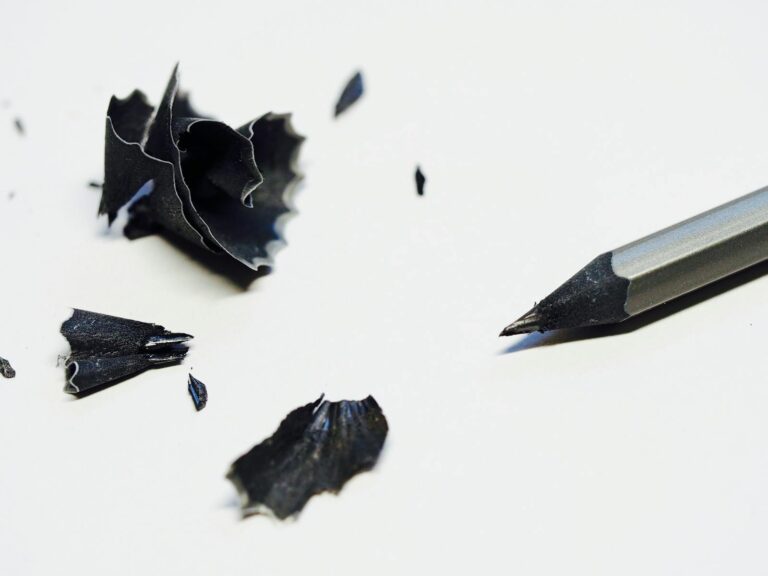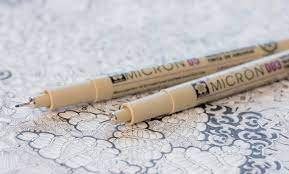Art Of Food Plating: How To Create The Perfect Looking Plate
It was once said by Nicholas Meyer that –
“Art just doesn’t happen by accident. It is about pulling out new tricks and trying out new things.”
But the question stands such – What would you consider as art?
To me, art is a sanctuary where creativity thrives. Whether it be in the form of dance or a large canvas painting, your way of expression knows no bounds here. It can be seen as a medium of portraying your inner voice and one such means is –
The Art of Food Plating

A plate full of vibrant colours, intrinsic designs and of course lip-smacking food, who does not love it? The saying that ‘we eat with our eyes’ is cliché but, in a sense, true as food when plated just right can influence the way we perceive the taste, quality of the dish. To add to it, an alluring and aesthetic looking plate of food is a culinary art which attracts everyone in this era of social media.
A well-presented plate of food can:
(1) Upscale Food (2) Improve Dining Experience (3) Build Reputation (4) Boost Creativity (5) Increase Profits (6) Create Free Advertising (7) Build Appetite.

Food Plating also proves as a creative way of marketing a restaurant’s menu. In this digital age, guests are ready with a camera just as the food hits the table. If the dish appeals to the diners visually, they would be keen to capture and post images online. An effective use of lighting and fixtures within the dining space can benefit the temptation of your dish.
Beyond The Bite: Exploring food plating styles
01. Traditional (Classic)
The traditional form of plating makes use of 3 basic food items – starch, vegetables and one main that is arranged in a specific way along with some sauce and a simple garnish. A simple guide to traditional plating is to think of the plate as a clock.
Main: Between 3 to 9 o’clock
Starch: Between 9 to 12 o’clock
Vegetables: Between 12 to 3 o’clock
Sauce is placed on or near the main ingredient while the garnish goes over the top to create elevation.

02. Landscape
This style of plating seeks inspirations from the “landscapes” around you. The food is placed in a long and low profile with a common inclusion being streaks and drizzles of purees and sauces. Colours and textures are factors involving major emphasis to provide the diners with a relatable look.
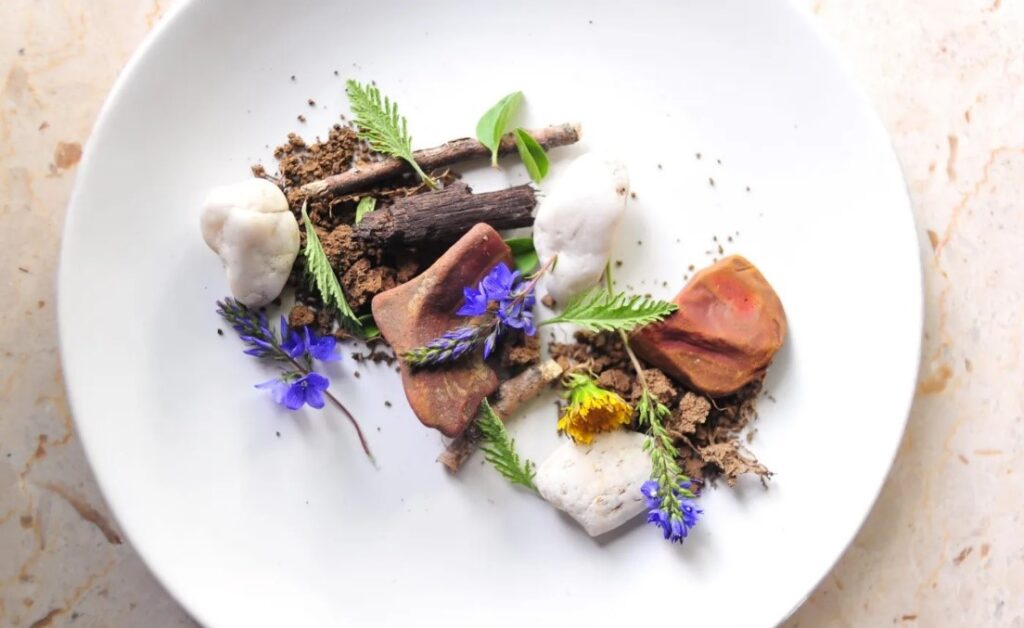
03. Free Form
Why should the shackles of classics bind you while showcasing art? The style of food plating is just the form to go rogue but in a slight intriguing way. Free form plating in many ways resembles modern day paintings, slightly speckled but carefully thought out. Nevertheless, no rules are involved here. So, if you call yourself a rule breaker, you have found your solace!

04. Alternative Receptacles
Fancy, as the term sounds, so is the style of plating. This form of food plating makes use of sleek material like glass or metal imparting a futuristic touch. A few instances being the use of test tubes for soup, syringes for sauces, coffee siphon for a broth among others.
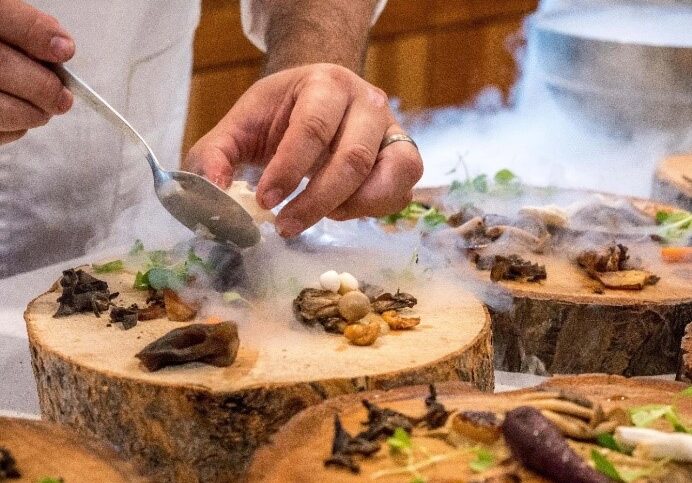
Plating 101: Tips & Tricks of Food Plating
01. Tableware: Just does not seem right when the size of the plate is not corresponding to the amount of food or the colours of the plate clash with that of the food isn’t it? Select the tableware that is rightly shaped, sized, coloured and textured.
02. Focal point: Whether the main element be a grilled steak or even a small seared scallop, your attention should be driven to that. Adjust the supporting elements on the plate considerately and the job is done!
03. Game of textures: To grab crispy, crunchy, chewy and creamy all in one bite is the dream of all food enthusiasts. The elements need to be arranged in a way that grabs all contrasting textures in one mouthful.

04. Height & scale: Stack your elements to build a sense of height. This proves as a dominating way of enhancing a diner’s experience.
05. Colour: A play with colours can convert dining into a sensory experience. Bright colours, neutrals or contrasting shades give an extra touch. Presenting the dish in a single colour is also a trend.
06. Odd one out: Arrangements of food three, five or seven creates a visual allure. Lack of balance can benefit you too.

07. Edible garden: It is common practice to use micro herbs or edible flowers as a garnish. Use these elements to take your plate of food from ordinary to exceptional. Although, make sure they are edible… 08. Less is more: At certain moments, less components can do wonders. Avoid cramming your plate with too many of the side elements Got an unwanted element? Hit it right out of the park!
The power of garnishes: More than just decorations
The ideal “cherry on top” to a well-plated dish is placing the correct garnish (an actual cherry on top in some cases too…). One of the reasons for people to be enticed towards a plate of food is the garnish. It is the element on the plate specifically placed for the aesthetic appeal but needs to not only complement but also enhance the flavours, create a burst of texture and add a pop of colour to the dish. It is what makes the dish complete in its entirety. A thoughtful garnish can turn the mere plate into a canvas which might even tell a story.
Unappetizing garnishes such as raw herbs or large chunks of citrus, garnishes with a strong odour or garnishes that take a long time to place on the dish? You might want to shun them right out of your plate! To know which garnishes should be used is one thing but to know when to use them is another.

Examples of garnishes that can be used along with their uses:
Fresh herbs like parsley, chives or basil tend to the freshness whereas a squeeze of citrus zest or a drizzle of balsamic reduction brings a touch of acidity. For textural contrast, consider crispy fried shallots or toasted nuts. Edible flowers lend a touch of elegance, while vegetable ribbons, like carrot curls or zucchini noodles, provide a playful touch. The best garnishes complement to the dish’s existing flavours, so a fried chilli might grace a spicy gravy, while a splash of herb oil can work wonders along with a creamy pasta dish.

To conclude, the art of food plating is way beyond just making a presentable dish. It is a culinary art that tantalizes the taste buds right from the first bite. By understanding the benefits of plating, from increased customer satisfaction to boosted sales, you can elevate your food presentation and transform your menu items into masterpieces. Dive into the world of creativity and use plating to create a multi-sensory experience that travels beyond taste. Remember, the key is to find the right style that can complement if not enhance your food and allow you to channel your creativity. Next time you plan to throw your food into a bowl, try to take a moment to plate the food intently. Do not be afraid to experiment, find inspiration around you and let your personality shine throughout. Might need a little practice but you will surely reach the restaurant-worthy standards eventually!


